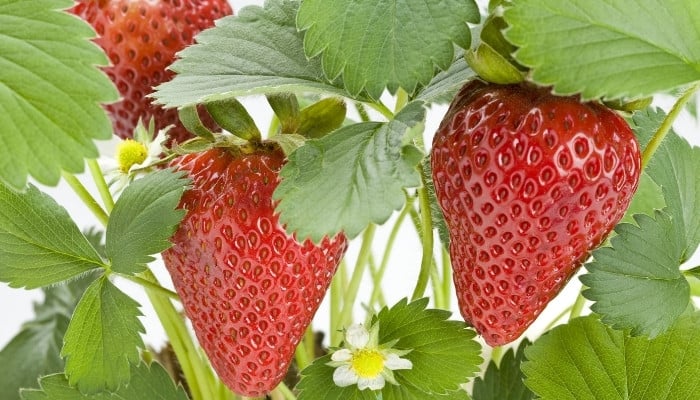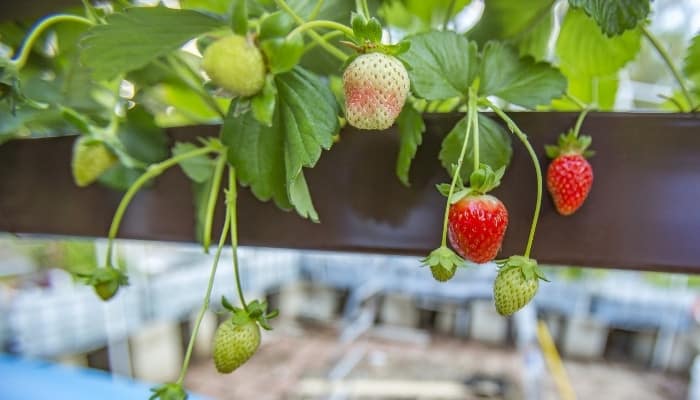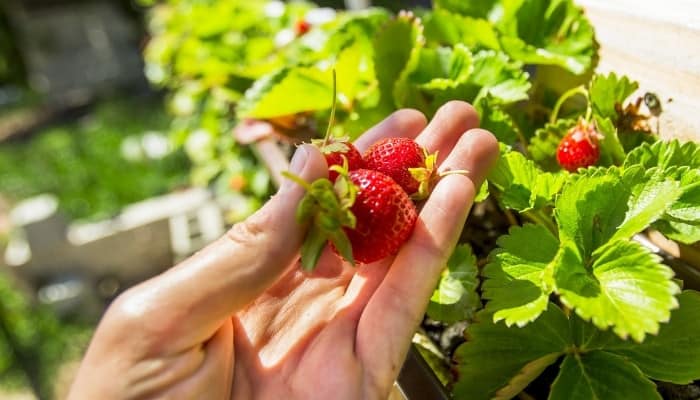Strawberries are amongst the most favored type of berries globally. Consequently, it’s understandable why many individuals are keen on attempting to cultivate them.
But, did you know that growing these iconic red fruits without dirt is a sure way to grow the biggest and best tasting berries around?
Can you grow strawberries with aquaponics? Strawberries are among the best plants to grow with aquaponics. Not only do they grow faster in an aquaponic system than they do in soil, but they also grow larger and juicier, and they taste better as well.
Read on below to learn everything you need to know about growing strawberries with aquaponics.
What Strawberry Varieties Are Best for Growing Aquaponically?
Growing aquaponic strawberries starts with one simple decision – which varieties are the best?
The answer to this question depends on your taste, local markets, and more.
That said, several species stand out from the hundreds of types of strawberries that you could choose to grow.
Albion

The Albion strawberry is one of the newest gaming-changing fruits to recently hit the markets.
Developed in California, these sweet and juicy berries are bright red, grow quickly, and have a classic conical strawberry shape.
Albion strawberries are ever-bearing fruits and grow to an average height of 12 inches.
Seascape

These small perennial strawberries are another popular berry with many fruit lovers. The berries are medium to large in size and are sweeter than many strawberry species.
The Seascape strawberry plant reaches maximum heights of 18 inches and is an ever-bearing species.
Tribute

The Tribute variety of strawberries are medium to large in size and have a glossy red color and a classic fruity taste.
The species put out new fruits roughly every six weeks after blooming begins.
Tribute strawberries are a day-neutral species that grow to at least 12 inches in height.
Ozark Beauty

A species of strawberry that does rather well in cooler climates is the Ozark Beauty.
These berries are an extra-sweet sort that has longer than usual runners. They bloom in much higher yields than similar varieties.
The Ozark Beauty strawberry plant is a day-neutral variety that grows to heights of 8 to 12 inches.
Are Strawberries Good for Aquaponics?
Strawberries are one of the very top fruits to grow aquaponically. Growing strawberries in an aquaponic system makes the process much easier than soil-based growing.
Below, we have a closer look at the pros and cons of growing strawberries aquaponically.
Pros
Growing strawberries with aquaponics has far more advantages than disadvantages.
Once your aquaponic system is set up, there is no equipment to lug around the garden. There are also no swarms of pests or messes to deal with.
Aquaponics also enables you to grow strawberries quicker, bigger, and tastier. However, the best advantage of aquaponic strawberries of all is that they grow all year long.
Cons
Despite the enormous advantages of growing strawberries aquaponically, there are a couple of drawbacks.
The main disadvantage is the cost of setting up an aquaponic system. If you already have one, however, you can cross this con off the list.
The second major drawback is that there is a pretty decent-sized learning curve that comes with growing aquaponics strawberries.
If you are already an experienced hydroponic gardener though, this con may not be much of a big deal.
Things to Consider
Before you decide whether growing aquaponic strawberries is right for you or not, take a moment to consider:
- Will you grow inside or outside?
- How will your strawberries be pollinated?
- What sort of fish will you use? (Check out our guide)
- Are you willing to foot the bill for upkeep?
- Will you grow for personal use or for a market?
- How much are you willing to learn and adapt?
How Do You Start Strawberry Seeds for Aquaponics?
Strawberry seeds for aquaponics can be started in various manners, including in soil, grow sponges, or rockwool.
As far as which starting method is the best, the choice is yours and often boils down to practice (and perhaps a bit of luck).
We suggest either starting strawberry seeds in moist potting soil or in a hydroponic seed starting system.
Whichever way you choose to go, once the plants’ roots reach 2 inches in length they are ready for planting.
If you decided to use potting soil, gently remove them, and rinse the soil from the roots. If started in a seed starting system, carefully lift them out.
At this point, your strawberries are ready for placing into your aquaponic system’s grow sites.
If using a growing medium, place the starter plants in, and then fill the rest of the space up with the medium.
Growing Time: How Long Do Strawberries Take?
Generally speaking, strawberries take between two and three years to start producing fruit.
However, some species grow for four or five years before producing large amounts of berries.
Fastest varieties:
- Albion
- Buddy
- Cambridge Favourite
- Christine
- Korona
- Royal Sovereign
- Seascape
- Tribute
- Ozark Beauty
Slower varieties:
- Alexandra Alpine
- Florence
- Fresca
- Mara des Bois
Aquaponic Strawberry Grow Systems

Strawberries will grow in just about any sort of aquaponic system. That said, vertical and elevated systems work best because they allow the plants to hang down.
Typical strawberry grow systems include NFT, vertical grow towers, aeroponics, and elevated ebb and flow systems.
How To Grow Aquaponic Strawberries
Growing strawberries aquaponically is quite a bit different than using traditional soil-based methods.
The biggest difference being that water, rather than soil, holds the key nutrients necessary for strawberry plants to grow and thrive.
Best Method
The best aquaponic method hands down for growing strawberries is vertical grow towers. Typically these grow towers work via the aeroponic method.
Aeroponic grow towers involve plants that are anchored vertically with the roots held in netted pots and exposed to the air.
The roots are regularly misted rather than being submerged or flooded and drained as in other aquaponic systems.
Water Temperature
In any aquaponic growing operation, water is the main ingredient for success. Strawberries do well in water temperatures between 60°F and 80°F.
A nifty trick for producing higher yields is lowering the temperature down to around 55°F and allowing the plants to “chill out” overnight.
pH Level
The pH level of water for aquaponic strawberries should be maintained and regulated at 5.5 to 6.0. A higher pH level causes leaf burn as well as stunts the overall growth of the plants.
Light
The second ingredient to growing amazing aquaponic strawberries is getting the light right.
Strawberries adore light and require approximately 12 hours of direct light each day. The sun is preferred, but grow lights work just fine for indoor growing.
Fish
The next step to growing the perfect aquaponic strawberries is using proper fish. In aquaponics, fish provide the nutrients so choosing the right one is key.
Tilapia is highly suggested for beginners as they are easy to maintain and produce plenty of beneficial food for the plants, but, crappie, carp, and koi are even better suited for strawberries.
Aquaponic Towers – Good For Growing Strawberries?
When it comes to growing strawberries, aquaponic towers are definitely the way to go.
These systems are far superior for growing strawberries than any other type of aquaponic system, period.
Below, we briefly discuss the advantages and disadvantages of aquaponic towers for strawberry growing:
Pros
The list of advantages of using an aquaponic tower for growing strawberries is a big one.
It starts off with the most obvious – it keeps the plants (and their precious fruits) off of the ground. That means fewer crops lost to pests and ground-based bacteria and disease.
The second advantage is that grow towers are vertical, which means they allow you more far more crops per square foot than other methods.
Aquaponic grow towers also allow you to space your grow sites all the way around the tower, whereas most aquaponic systems only allow for grow sites on the “top” side of the grow pipes or growing tray.
Setting up grow towers is much quicker than assembly other more complex aquaponic grow systems as well.
Furthermore, they are quick and easy to maintain on top of practically running on auto-pilot once set up.
Cons
Growing strawberries with aquaponic towers have a long list of pros, but it isn’t without a few basic cons.
The first and biggest disadvantage is that there are higher initial costs to get a system up and going than with more basic forms of aquaponics.
The next real drawback to using aquaponic towers is that they require a few more components than other systems.
For example, they need a timer, a more powerful water pump, and some sort of sprayer or misting mechanism.
The last con is the learning curve involved with the entire process. From set up to planting, harvesting, and maintaining the system in general, there is quite a bit to learn.
That means there is plenty of room to make mistakes (which may be costly ones).
DIY
If you’re the do-it-yourself kind of person, we suggest building an aquaponic grow tower from PVC tubes (like the one in the video below from Donald Porta).
They are cheaper than many pre-made systems, keep the berries protected from ground-based pests and disease, and allow for plenty of room between plants.
They also let the berries hang down.
Pre-Made
Our recommendation for a pre-made tower is the Nutrabinns Aquaponics Garden Tower.
It’s a tried-and-true system, comes from a well-known manufacturer, and is both easy to set up and use.
This grow tower system ensures that your strawberry growing operation gets off the ground smoothly.
Troubleshooting Problems With Aquaponic Strawberries
A few of the most common problems (and solutions) with aquaponic strawberries are:
Heat
Excessive exposure to temperatures above 80°F results in shocked or dead strawberry plants.
Not only does the water need to remain between 60°F to 80°F, but the top end of the plants also requires the same comfort zone.
This problem is easily preventable by monitoring both the water temperature and the temperature of the growing area in general.
Whether indoor or out, installing proper ventilation in the form of fans, swamp coolers, or AC units helps maintain your strawberry’s comfort zone tremendously.
In addition, there are several easy ways to help keep aquaponic water cool:
- Install a cooling coil
- Add coolant to the water
- Paint the reservoir a dark color
- Keep the reservoir in the shade if outside
- Add cool water when it heats up
Algae
The abundant growth of algae is one of the most common problems for new aquaponic gardeners.
Algae forms in the water for various reasons – too much light, warm water temps, and lack of proper sanitation being the most common.
When algae builds up in aquaponic systems, it begins to feed on nutrients that are intended for your plants.
In other words, the more algae your system has in it, the less food your plants have access to.
Thankfully, it’s an easy fix.
To avoid developing algae in your system, limit the reservoir’s exposure to bright light by positioning them in the shade, burying them in the ground, or painting them solid colors.
Another great way to prevent algae buildup is to install some sort of filtration system that helps clean the water in your tanks.
Wrong Fish
Using the wrong sort of fish is another common mistake when growing strawberries with an aquaponic system for the first time.
Each species of fish provides a unique set of nutrients for plants to feed on, and some fish species are just not compatible for supporting specific types of crops.
Stick to tilapia, carp, crappie, or koi fish for growing strawberries, and you’ll do just fine.
Final Thoughts About Aquaponic Strawberries
Growing aquaponic strawberries is fun, rewarding, and educational. Most of all, it’s one of the best-proven methods for growing enormous amounts of these tasty red berries.
Aquaponic strawberries can grow faster, bigger, and healthier than most soil-grown plants. Once your aquaponic system is installed, they practically grow on their own!
Image credit for Seascape strawberry: Wild Berry Farm

